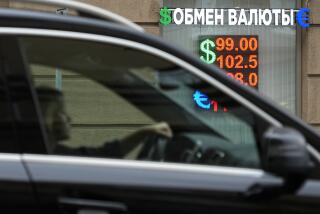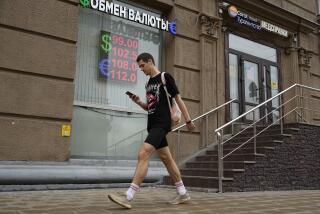Yeltsin to Lop 3 Zeros Off Ruble in Currency Reform
- Share via
MOSCOW — President Boris N. Yeltsin, declaring that Russia’s era of inflation has come to an end, announced Monday that his government will issue new currency that lops three zeros off the hyper-inflated ruble.
Beginning in January, each new ruble will be worth 1,000 of today’s rubles--symbolizing a break in the six-year period of high inflation that has left Russians paying thousands of rubles just to buy a loaf of bread.
“We declare today that there will be no more inflation,” Yeltsin said. “An end has been put to it. New zeros will never again appear on our bank notes.”
Despite the president’s optimism, his announcement alarmed many Russians who vividly recall losing their savings in earlier currency “reforms” and worry how they will fare in this conversion. In addition, some economists and politicians warned that renumbering the ruble will lead to price increases that will harm the poor most of all.
Yeltsin, however, said he would guarantee that Russians will not lose money because of the introduction of the new notes, and he promised a smooth conversion that will take place over five years.
“Nobody is going to lose anything as a result of the reform,” the president pledged. “Nobody’s interests will be trampled on; the reform will not amount to confiscation.”
Some economists questioned whether Yeltsin’s pronouncement was premature and said the move to convert the currency could backfire if the ruble drops further in value.
“In a sense, this is self-deceit on the part of the government,” said economist Nikolai P. Shmelev, chief researcher at the Institute of Europe. “They have just curbed galloping inflation, and already they are trying to pretend that it never happened at all.”
While the government is billing the move as an attempt to help consumers, Shmelev said that in reality it is an effort to shore up Russia’s political and monetary reputation in the international community.
“They are trying to restore the prestige of Russia’s national currency with foreign investors, financiers, banks and companies,” he said. “They are saying, ‘Take a look at us: We are decent, honest, reliable and trustworthy partners, whose currency is so stable you don’t have to worry about extra-zero bills anymore.’ ”
During Soviet times, the government artificially maintained the value of the ruble at $1.60 or more, but its worth plummeted during the transition to capitalism.
Today it takes 5,800 rubles to equal one U.S. dollar--making any Russian who earns the equivalent of $175 a month a ruble millionaire on payday.
Most Russians distrust banks and keep their savings in cash--preferably dollars or German marks. Earlier this year, the government reported that nearly 20% of the currency in use in Russia is dollars.
In the early 1990s, government withdrawal of high-value ruble notes from circulation and restrictions on the conversion of rubles to dollars prompted panic trading and robbed many citizens of money they had saved.
For the past 18 months, Yeltsin’s administration has fought a painful battle with inflation. Breaking with past practices, the government stopped printing money to pay bills.
Russia’s inflation fell to 22% last year and is running at about 12% this year. The government has predicted it will be about 5% next year.
“Today we reliably control money circulation and control inflation,” Yeltsin said. “The prices of basic goods are practically stable. And we are confident that they will remain so.”
Russia’s economic crisis, however, is far from over. The government’s strategy has left it without the cash it needs to pay trillions of rubles it owes, contributing to a cycle of debt that has left thousands of companies across the country broke and unable to pay salaries or taxes.
In its plan for renumbering the currency, the government appears to have learned from earlier debacles and is promising a changeover process that will be fairer than ruble conversions of the past.
On Jan. 1, officials said, the government will introduce ruble notes with face values of five, 10, 50, 100 and 500 rubles. It also will introduce new coins valued at one, five, 10 and 50 kopecks and one, two and five rubles.
Both the new and the old currency will coexist for a period of one year, while the old notes are gradually removed from circulation. After that, banks will accept old rubles in trade for a period of four years.
“Renumbering the currency will make life simpler,” Yeltsin said. “A ruble, not a thousand rubles, will become a unit. It will be easier to count without so many zeros.”
*
Economists agreed that the plan will simplify transactions and cut down on the number of bills that shoppers must carry with them.
“It will become harder for dishonest salespeople to cheat customers and easier for customers to operate with smaller numbers,” said Pavel G. Bunich, a prominent economist at the National Economics Academy. “The re-numeration will reduce the number of people with bulging pockets, stuffed with millions of rubles.”
At the same time, they said, the simplification of the currency will cause prices to rise because of the natural tendency of merchants to round up the price of small items. For example, a product that now costs 1,900 rubles would probably be priced at two rubles under the new system.
Bunich estimated that this practice will result in overall price growth of 8% during the five-year conversion period.
“It is very sad that the long-suffering Russian people will be fleeced again,” he said. “For them, it doesn’t make any difference whether this was done deliberately or unintentionally.”
Alexei V. Kuznetsov of The Times’ Moscow Bureau contributed to this report.
More to Read
Sign up for Essential California
The most important California stories and recommendations in your inbox every morning.
You may occasionally receive promotional content from the Los Angeles Times.













